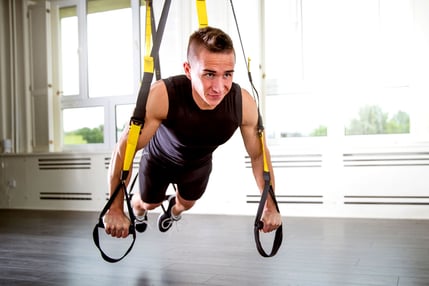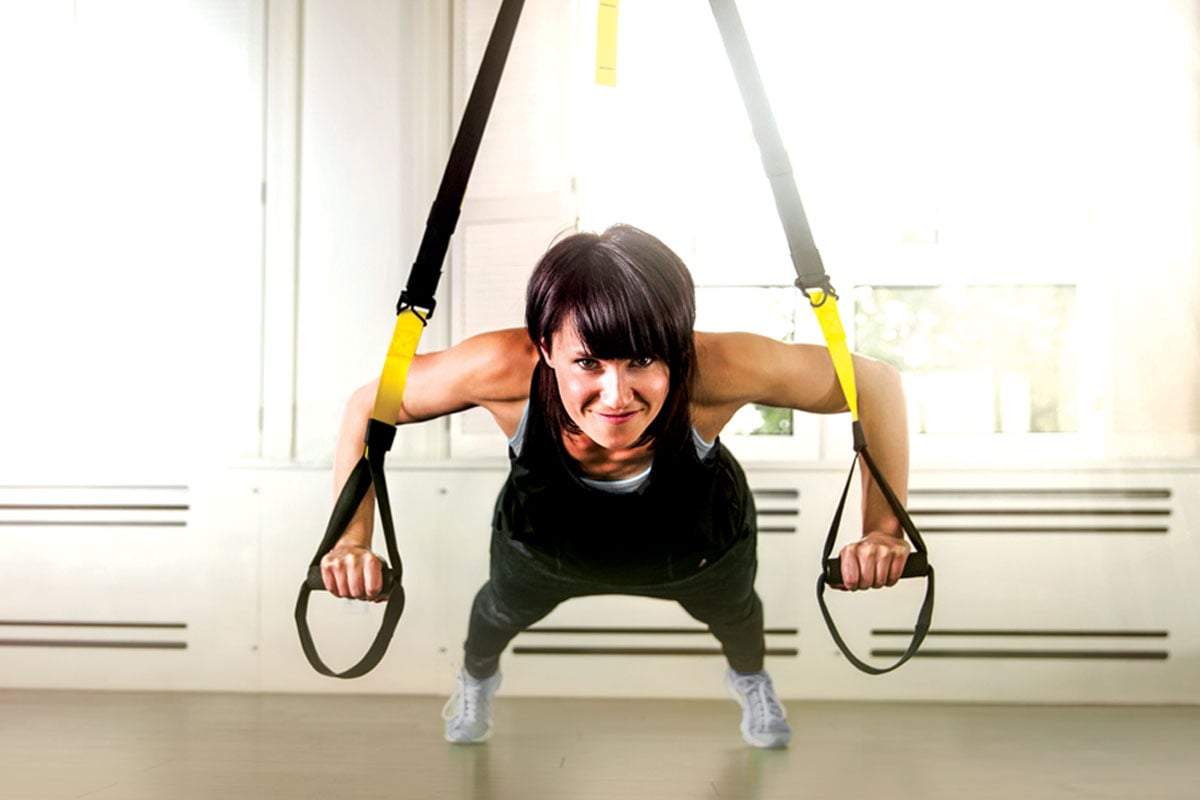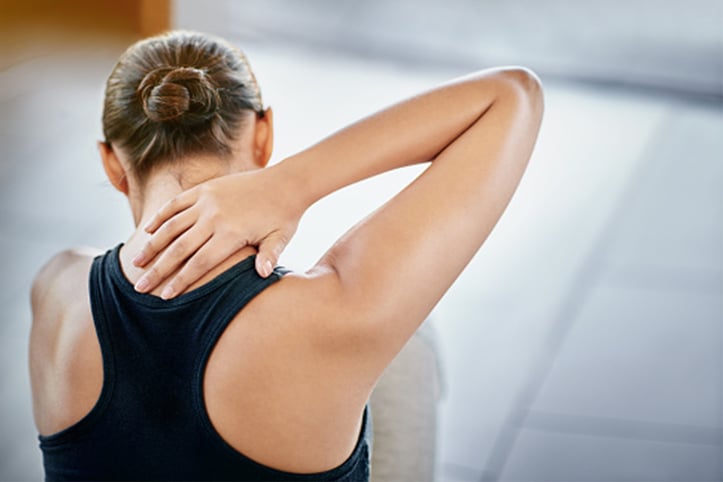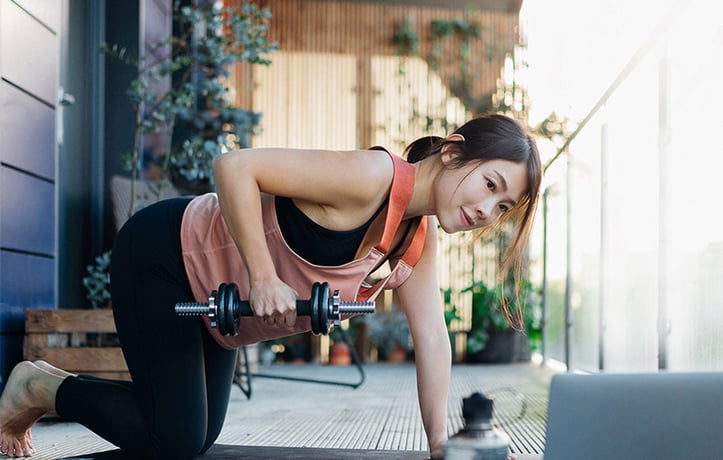Functional Movement and Training That Are Totally Accessible
Originally published in the summer 2016 issue of the American Fitness Magazine.
To earn 2 AFAA/0.2 NASM CEUs, purchase the CEU quiz ($35) and successfully complete it online.
Many certified personal trainers implement the TRX Suspension Trainer, but often with only select clients and small groups. They know TRX® founder, Randy Hetrick, is a former Navy SEAL, so they apply this tool designed to toughen men’s muscles on military missions with none but the athlete and the ultra-fit. Most have yet to discover the tool’s surprising potential to improve muscle strength, functional balance and flexibility in older adults.
History of TRX
Hetrick constructed the first version of the TRX out of web strapping while deployed to Southeast Asia as a SEAL Squadron Commander. He launched a commercial version of the suspension device in 2004, marketing it to elite commandos and other military personnel seeking the ultimate workout. Athletes soon clamored to get their hands on a strap. “We focused on the more elite end of the spectrum for the first five years or so,” says Hetrick. While ultra-fit people sweated and grunted through suspension workouts too tough for many to imagine, the regular and older populations largely avoided TRX training.
As Hetrick’s body of Master Trainers and trained fitness professionals ballooned, the TRX’s applications for desk jockeys, seniors and even injured individuals became increasingly apparent. “It’s as useful at unloading and stabilizing as it is for super loading and destabilizing,” states the entrepreneur. He cited the example of a squat, an exercise many seniors struggle to perform. “To split the weight between the upper and lower body makes it more doable.”
An older adult with weak thigh muscles may be able to execute a squat for the first time in years and an individual with pain or restrictions in the knee can learn how to fractionally load it without pain. Anyone struggling with balance can rely on the strap for partial support.
Senior Population Research
A German study observed 11 participants aged 60 and older with no previous suspension training experience.(4) All followed a 12-week TRX training program, performing seven different exercises three times per week, and were asked to subjectively report positive effects in the areas of flexibility, strength, gait and balance from the TRX regimen.
Thirty-six percent of participants reported a decline in musculoskeletal pain during the intervention. Twenty-seven percent reported that the workouts incited knee, hip or thoracic spine pain, which suggests that trainers should proceed with caution when implementing the TRX with this population. Ninety-one percent of the participants wanted to continue TRX training after the study concluded.
Dr. Christian Thompson, associate professor of kinesiology at the University of San Francisco, has published scientific reports on exercise programming for older adults in peer-reviewed journals including Medicine & Science in Sports & Exercise, the Journal of Aging and Physical Activity, and the Journal of Applied Research.
Dr. Thompson conducted an internal TRX study that was presented at the 2013 ACSM Health and Fitness Summit in Las Vegas. (7) The investigation followed 12 subjects, ages 75 and older. Six individuals served as a control group over the course of the eight-week study. The other six trained for 60 minutes twice a week, performing mobility, strength, gait and dynamic balance activities with the TRX.
Participants performed the Functional Reach Test (FRT), 30-second chair stand (CS) test and the Timed Up and Go (TUG) test before and after the eight-week training period. Anterior reach displacement (as measured by the FRT and TUG test results) improved significantly in the exercise group but not in the control group. This outcome led Thompson and his colleagues to conclude that suspension training is a feasible mode of exercise for older adults and can lead to improvements in functional fitness.
Dr. Thompson reports studies are underway to compare spinal compression while doing rows or push-ups on the TRX with forces experienced when doing comparable activities on the floor or with a cable device. So far, research indicates that suspension training is a safe means of improving core strength and function in the absence of major back pathology. He has received grant money for fall prevention research and plans to include the TRX in some of the studies.
Balance Benefit
Many older adults fear falls. Those with balance and functional stability deficits may resist trying one-legged balance activities or stepping onto an unstable surface even when offered spotting help by a trainer. To assuage this fear, trainers may allow a client to grip a fixed object such as a bar or wall, which will prevent him or her from learning to use muscles to stabilize in unstable circumstances.
With the TRX, older adults can try new exercises with less fear of toppling over. The device provides “a dynamic point of stability,” observes Hetrick. “You’re not hanging on to a fixed object, which gives too much stability. It’s a safety net. You get the stability that you need.”
Dr. Thompson teaches older adults how to use the TRX in a small group setting. The suspension trainer offers an excellent spotting mechanism to facilitate balance, strength and mobility exercises, he points out.
Once the client learns the basics and is comfortable with the TRX, it can be used to support work on balance pads, half foam rollers and BOSUs®. “You can balance on one leg and use the TRX as a dynamic point of stability to activate all the way from ankle up to knee and hip and up into spine,” claims Hetrick.
Flexibility Tool
The TRX can be employed to mobilize joints and improve flexibility. “Using gravity to decompress the spine, you can allow yourself to fall away from the strap,” says Hetrick. The long torso stretch is one example of this. “You hang away from the anchor with the hips outward—no other tool lets you do it. Given the dynamic nature of the strap, each individual can work tight spots. Using gravity to elongate tissues has become one of the staples of the suspension trainer.”
How it Works
When the TRX was first introduced, many fitness professionals struggled to get started. “No one had invented a strap like this and people didn’t understand how you would use it,” comments Hetrick. “Every time I was in front of someone, I had to start from scratch. Pretty quickly we realized the key to success with this is to rapidly upskill training pro so they can make appropriate adjustments for different levels.”
Hetrick systemized the presentation so fitness professionals were taught not only how to use the device, but also how to progress and regress exercises. He now considers his San Francisco-based company to be as much of an educational as a product company.
Before exercise begins, the TRX straps are attached to a fixed anchor point about 6 feet above the ground. There are six basic body positions. For the sake of simplicity and ease for seniors who have difficulty getting down and up from the floor, the three standing positions will be highlighted. The first is Stand Facing the anchor point (SF), the second is Stand Facing Away from the anchor point (SFA) and the final is Stand SideWays to the anchor point (SSW).
There are five length adjustments for the suspension straps: Long (L), Mid Calf (MC), Mid Length (M), Short (S) and Over Shortened (OS). TRX instructor training manuals assign an ideal strap length for each exercise. (3)
A trainer should ensure the client balances his or her body weight when doing the activities so no slack is observed in either strap and no sawing motion occurs at the top of the strap (locking loop area).
For many exercises, a base-of-support adjustment can be used to make balance easier or more challenging. A staggered stance would be easiest, followed by a position with the legs wide apart. More challenging would be activity with the feet hip-width apart or bearing all weight on one leg. (3)
Exercise intensity varies according to body angle. By reducing the angle between the body and surface, the center of gravity (COG) moves outside the base of support, more load is transferred to the TRX and the participant is called upon to generate more force.
Sample Exercises
“You can unload arthritic joints without the pain of an unassisted squat,” Dr. Thompson adds. In addition to training lower body muscles that are so essential to older adults’ ability to perform activities of daily living (ADLs), this closed chain exercise also teaches the individual how to engage core muscles. “With four points of contact, the core turns on automatically. We have good research to support that.”
A chair can be used during the squat with a new client. Reassure him or her that the straps are there to assist in standing up. Instruct the individual to keep the chest open while using the arms to unload some of the weight. Cue the participant to start with feet hip-width apart, toes and knees tracking forward, and grip the TRX handles with the arms bent, elbows close to the body and palms facing in. The client will now sink down into a squat of a comfortable depth and then keep the weight in the heels while driving upward to the starting position.
The participant can further unload the knees by adopting a slight body tilt away from the anchor. The shallower the exerciser’s angle is with the floor, the less weight will be borne on the knees. Having the client grip both foot cradles together while squatting can advance the exercise. Single-leg and transverse squats are other more difficult variations. Alternating the squat with a row, calf raise or an overhead reach can add complexity and further challenge for the more advanced older adult.
Ta-Da for Mobility and Balance (SSW, S)
A closed chain exercise Dr. Thompson created to facilitate the mobility of the ankles, hips, thoracic spine and shoulders, the Ta-Da is performed with the client facing sideways to the anchor. Instruct the individual to plant feet slightly wider than hip-width apart and grip both foot cradles with the inside hand. The client will then raise the outside hand at an upward angle before reaching down and across midline and touching the inside knee. Cue the participant to then raise the outside hand upward while rotating and pivoting away from the anchor point and rising up on the trailing toe. Clients may need spotting support during the rotation if they have difficulty maintaining balance.
A high, mid and/or low row can be performed with the same short strap setting. Beginners should start facing the anchor point with bodies aligned in a nearly upright position, feet wider than shoulder-width apart or in a staggered stance. Instruct client to grip the handles and fully extend arms, hanging back in a reverse plank position.
Once proper starting alignment is achieved, the participant should pull shoulders down and back, retract the scapula, and drive elbows back to move the torso toward the anchor. Length in the spine should be maintained throughout the exercise.
Intensity can be progressed by standing at a shallower angle with respect to the floor or doing a single-arm row. Balance can be challenged by standing with feet close together, on one leg, or by executing alternating knee lifts or marches as rows are performed.
TRX Side-to-Side Lunge (SF, M) for Lower Extremity Strength Plus Hip and Knee Mobility
Walking, cycling and running are popular activities done in the sagittal plane. The TRX Side-to-Side Lunge provides an opportunity to work in the less-practiced frontal plane. In addition, it will improve stability and balance while recruiting the quadriceps, hamstrings and gluteus maximus, as well as increasing mobility in the hip and knee joints.
 “TRX training courses teach instructors to properly set up the suspension trainer for different exercises and when to apply progressions and regressions as well as adjust load and tempo.”
“TRX training courses teach instructors to properly set up the suspension trainer for different exercises and when to apply progressions and regressions as well as adjust load and tempo.”
Instruct client to grip the handles and maintain tension on the strap while keeping elbows close to the body throughout the exercise. During movement, the individual should hinge slightly forward at the hips, keep spine long and push the buttocks back during the weight shift to unload the knees. Cue them to drive through the mid-foot on the bent leg side to transition to the other side.
Standing Plank for Core Stability (SFA, M-L)
The standing plank is an ideal core exercise for clients who have difficulty getting down on and up from the floor. The individual faces away from the anchor point with feet hip-width apart and arms extended while adopting an outward lean sufficient enough to incite overload on the core complex. Shoulders ought to be pulled down and away from the ears and the belly should be pulled upward to keep the lower spine neutral as the plank is held. Instruct the client to breathe normally.
“You can manipulate that standing plank a number of ways,” notes Hetrick. “You can do marches, a shallow chest press or lift one leg at a time.” Those with wrist issues can be instructed to slip their forearms through the cradles before performing the exercise so there is no need to grip.
Standing Roll Out for Shoulder Mobility and Core Stability (SFA, M)
TRX Senior Master Instructor Leigh Crews explains to do the Standing Roll Out, instruct client to stand facing away from the anchor with feet hip-width apart and slide forearms through the foot cradles, palms facing inward. This allows the individual to do the roll out without stressing the wrists. The starting position is on the balls of the feet with a slight away-from-the-anchor lean.
Cue client to brace through the core, keep shoulders down and away from the ears, and press heels back (without overstretching gastrocnemius) throughout the activity. The participant will raise arms upward to about eyebrow level, which will incite a full-body lean and intense core engagement. The exercise can be regressed by adopting a wide or offset stance.
TRX Training
TRX provides a basic Suspension Training course as well as a Group Training and Functional Training Course. These eight-hour courses, taught by TRX Master Trainers, are offered in major cities in the U.S., Canada and the United Kingdom.
The current listing of workshops can be viewed at www.trxtraining.com/products/courseschedule. Many DVDs are also available and can be purchased and then streamed or downloaded from www.trxtraining.com/shop/workouts-exercises/downloads-dvds.
Brandon Wagner, a TRX Senior Master Trainer in Tucson, Ariz., has a long history working with older adults, first at the world-renowned Canyon Ranch and now at Select Fitness. He considers the TRX a “must use” tool for seniors. “The suspension trainer requires you to use your body the way it was intended to be used.
“With seniors, balance and coordination are two things lost most quickly.” Wagner is chagrined when trainers park older adults on chairs. “This is the last thing this population should be doing.” Just like with canes and walkers, “they get dependent on something inhibiting them.” Wagner urges trainers to teach older clients to use their whole body. He believes if more fitness professionals were educated on how to implement the suspension trainer with this population, many more older adults would keep their independence longer. “Carrying a bag of groceries requires balance, stability and strength. They’ll see greater return and be more independent in the long term.”
“We’re working with a tool that is leading the trend when it comes to functional movement and functional training and is totally accessible,” enthuses Hetrick. “We’re about helping people move better no matter what age.”
References
- CARBONNIER, A. AND MARTINSSON, N. “EXAMINING MUSCLE ACTIVATION FOR HANG CLEAN AND THREE DIFFERENT TRX POWER EXERCISES: A VALIDATION STUDY.” HALMSTAD UNIVERSITY BIOMEDICINE ATHLETIC TRAINING BACHELOR’S THESIS. HALMSTAD, SWEDEN, 2012.
- DANNELLY, B.D., ET AL. “THE EFFECTIVENESS OF TRADITIONAL AND SLING EXERCISE STRENGTH TRAINING IN WOMEN.” JOURNAL OF STRENGTH AND CONDITIONING RESEARCH, 25, NO. 2 (2011): 464-71.
- FITNESS ANYWHERE. TRX SUSPENSION TRAINING SPORTS MEDICINE: USER’S GUIDE. SAN FRANCISCO: FITNESS ANYWHERE, INC., 2010.
- GAEDTKE, A. AND MORAT, T. “TRX SUSPENSION TRAINING: A NEW FUNCTIONAL APPROACH FOR OLDER ADULTS—DEVELOPMENT, TRAINING CONTROL AND FEASIBILITY.” INTERNATIONAL JOURNAL OF EXERCISE SCIENCE, 8, NO. 3 (2015): 224-33.
- NUNEZ, T. AND KRAVITZ, L. “SUSPENSION EXERCISE: THE RESEARCH.” IDEA FIT TIPS, 13, NO. 11 (2015).
- STRAY-PEDERSEN, J.I., ET AL. “SLING EXERCISE TRAINING IMPROVES BALANCE, KICKING VELOCITY AND STABILIZATION STRENGTH IN ELITE SOCCER PLAYERS.” MEDICINE & SCIENCE IN SPORTS & EXERCISE, 38, NO. 5 (2006; ABSTRACT): S243.
- THOMPSON, C.J., ET AL. “SUSPENSION TRAINING IMPROVES FUNCTIONAL PERFORMANCE IN COMMUNITY-DWELLING OLDER ADULTS.” NASM HEALTH AND FITNESS SUMMIT. (2013; ABSTRACT).
- TRX. ONLINE VIDEO. “TRX FOR ZOOMERS: STRENGTH AND POWER—PART 2.” TRX SENIOR MASTER TRAINER LEIGH CREWS (2015).

















